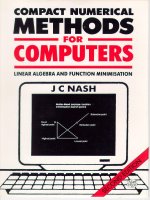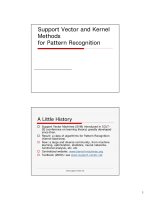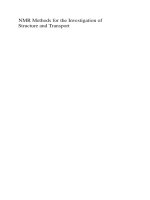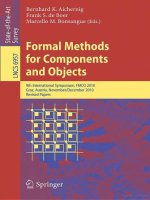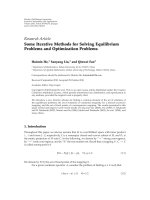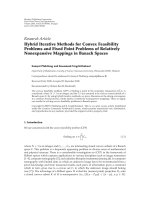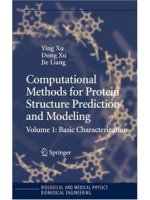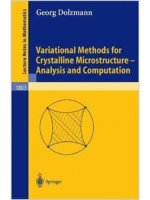Nonrigid registration methods for myocardial perfusion mri and cerebral diffusion tensor mri 1
Bạn đang xem bản rút gọn của tài liệu. Xem và tải ngay bản đầy đủ của tài liệu tại đây (8.96 MB, 137 trang )
NONRIGID REGISTRATION METHODS FOR
MYOCARDIAL PERFUSION MRI AND
CEREBRAL DIFFUSION TENSOR MRI
LI CHAO
NATIONAL UNIVERSITY OF SINGAPORE
2012
2
NONRIGID REGISTRATION METHODS FOR
MYOCARDIAL PERFUSION MRI AND
CEREBRAL DIFFUSION TENSOR MRI
LI CHAO
(B.Sc.), University of Science and Technology of China
a thesis submitted for the degree of
doctor of philosophy
DEPARTMENT OF ELECTRICAL AND COMPUTER
ENGINEERING
NATIONAL UNIVERSITY OF SINGAPORE
2012
Acknowledgments
First and foremost, I would like to express my sincere appreciation to my
supervisor, Asst. Prof. Sun Ying. This dissertation is definitely not possib l e
without her guidan ce and persistent help. I would also like to thank my
mentor during the exchange in the Chinese University of Hong Kong, Asst.
Prof. Wang Xiaogang, for his advice.
Second, I would like to thank my thesis committee, Prof. Ong Sim Heng
and Asst. Prof. Yan Shuicheng and an o nymous reviewers for their valuable
comments.
Third, I than k Mahapatra Dwarikanath, Jia Xiao, Hiew L i t t Teen for
their enlightening suggestions during our discussions, and I thank Francis
Hoon Keng Chuan and other friends in the Vision and Machine Learning
Lab who have helped me in my study.
Last but surely not the least, I woul d exp re ss my heartfelt thanks to my
parents and my wife for their precious support and encoura gem e nt.
i
ii ACK NOWLEDGMENTS
Contents
Acknowledgments i
Conte nts iii
Summary vii
List of Tables ix
List of Figures xi
List of Abbreviations and Symbols xv
1 Introduction 1
§ 1.1 Moti vation . . . . . . . . . . . . . . . . . . . . . . . . . . . . . 1
§ 1.2 Scope and Contributions . . . . . . . . . . . . . . . . . . . . . 5
§ 1.2.1 Pseu do Ground Truth Based Perfusion Sequence Reg-
istration
. . . . . . . . . . . . . . . . . . . . . . . . . . 5
§ 1.2.2 Contour-Image Registration and Its Application to D-
iffusion MRI
. . . . . . . . . . . . . . . . . . . . . . . . 6
§ 1.3 Thesis Or g an i zat i on . . . . . . . . . . . . . . . . . . . . . . . . 8
iii
iv CONTENTS
2 Back g round 9
§ 2.1 Magn et i c Reson a n ce Imagi n g ( MR I) . . . . . . . . . . . . . . 9
§ 2.2 Ischemic Heart Disease and Perfusion MRI . . . . . . . . . . . 10
§ 2.3 Sm a ll Vessel Disease and Diffusion MRI . . . . . . . . . . . . . 14
§ 2.4 Introduction to Image Registration . . . . . . . . . . . . . . . 19
§ 2.4.1 Si m i la r ity Measures . . . . . . . . . . . . . . . . . . . . 20
§ 2.4.2 Transformation Models . . . . . . . . . . . . . . . . . . 28
§ 2.5 Regi st r at i on i n Myo ca rdial Perfusi on MRI . . . . . . . . . . . 35
§ 2.6 Regi st r at i on i n D iff u si on Tensor MRI . . . . . . . . . . . . . . 38
3 The Pseudo Ground Truth Method 41
§ 3.1 Introduction . . . . . . . . . . . . . . . . . . . . . . . . . . . . 41
§ 3.2 PGT-based Registration for General Perfusion MRI . . . . . . 44
§ 3.2.1 Data Fidelity Term . . . . . . . . . . . . . . . . . . . . 45
§ 3.2.2 Sp a ti a l Sm ooth n ess Const r ai nt . . . . . . . . . . . . . 45
§ 3.2.3 Temporal S m oothn ess Const r a int . . . . . . . . . . . . 48
§ 3.2.4 Ener g y Min i m i zat i on . . . . . . . . . . . . . . . . . . . 49
§ 3.2.5 Prel iminary Results . . . . . . . . . . . . . . . . . . . . 52
§ 3.3 Regi st r at i on of Myo car dial Perfusion MRI . . . . . . . . . . . 55
§ 3.3.1 Ini t ia l Ali gnment . . . . . . . . . . . . . . . . . . . . . 55
§ 3.3.2 Heart Ventricle Segmentation . . . . . . . . . . . . . . 57
§ 3.3.3 Nonr i gi d R egi st r at i on . . . . . . . . . . . . . . . . . . . 63
4 The Contour-I m ag e Re gi str ati on Method 67
§ 4.1 Introduction . . . . . . . . . . . . . . . . . . . . . . . . . . . . 67
§ 4.2 Acti ve Image . . . . . . . . . . . . . . . . . . . . . . . . . . . 71
CONTENTS v
§ 4.2.1 B-s p l ine FFD . . . . . . . . . . . . . . . . . . . . . . . 71
§ 4.2.2 En er gy Functional . . . . . . . . . . . . . . . . . . . . 72
§ 4.2.3 En er gy Min i m i zat i on . . . . . . . . . . . . . . . . . . . 73
§ 4.2.4 Pr eli m i n a r y Resu l t s . . . . . . . . . . . . . . . . . . . . 74
§ 4.3 Free-form Fiber s . . . . . . . . . . . . . . . . . . . . . . . . . 78
§ 4.3.1 Fiber Model . . . . . . . . . . . . . . . . . . . . . . . . 81
§ 4.3.2 Fiber- t o- DTI Regist r at i on . . . . . . . . . . . . . . . . 82
5 Results 95
§ 5.1 Data Acquisition . . . . . . . . . . . . . . . . . . . . . . . . . 95
§ 5.2 Perfusion MRI . . . . . . . . . . . . . . . . . . . . . . . . . . . 96
§ 5.3 Diffu si on MRI . . . . . . . . . . . . . . . . . . . . . . . . . . . 116
6 Conclusion and Future Work 127
§ 6.1 Concl u si on and Discussion . . . . . . . . . . . . . . . . . . . . 127
§ 6.1.1 Car d i ac Perfusion MRI . . . . . . . . . . . . . . . . . . 128
§ 6.1.2 Cerebral Diffusion MRI . . . . . . . . . . . . . . . . . . 130
§ 6.2 Future Work . . . . . . . . . . . . . . . . . . . . . . . . . . . . 132
§ 6.2.1 Car d i ac Perfusion MRI . . . . . . . . . . . . . . . . . . 132
§ 6.2.2 Cerebral Diffusion MRI . . . . . . . . . . . . . . . . . . 134
Bibliography 135
List of Publications 149
vi CONTENTS
Summary
As the two leading causes of deat h, ischemic heart disease and cerebrovascular
disease are of great research importance. Perfusion Magnetic Resonance
Imaging (MRI) and diffusion MRI have emerged as the most effective non-
invasive diagnostic tools respectively for ischem i c heart disease and cerebral
ischemic small vessel disease. Th is thesis discusses the nonrigid registration
problems in these two imaging techniques.
To compensate patients’ breathing and precisely trac e the perfusion sig-
nal over time, nonrigid registration of the perfusion sequence is requi r ed .
This regist r at i o n was conventionally accomplished by pairwisely mapping
images from different perfusion phases but it often failed to handle the great
mismatch of intensity distributi on s between the referen c e an d floating images
due to the variation of t h e contrast concentration. We p r opose to register the
observed sequen ce to a pseudo gro u n d truth (PGT), which is a motion/noise
free sequence that is estimated from the observed on e, and having almost
identical intensity variations as the original sequence. In contrast to pairs
of ima ges within the observed sequence, the correspondin g pairs of images
between the obser ved sequence and the PGT have similar i ntensities, and
vii
viii SUMMARY
thus the registration problem is greatly eased. Our experimental r esults on
20 cardiac perfusion MR scans have quantitatively an d qualitatively shown
that the method is able to effectively compensate for the elastic deformation
of the heart in the myocardial perfusion sequence.
The state-of-the-art DTI analysis frameworks, e.g., Voxel-Based Mor-
phometry and Tract-Based Spatial Statistics, are based o n image-to-image
registration and cannot analyze brain fiber tracts. The brain fiber tracts re-
construction, i.e. , tractography, is usually accomplished by linking the prin -
cipal directions of diffusion tensors, which often early terminates at white
matter (WM) l esi o n regions. Besides, tractography segmentation and estab-
lishing corresponden ces among fiber tracts are challenging. We propose a
novel fiber-to-DTI registration method which deforms a manually annotated
whole brain fiber mo d el to diffusion tensor images of new subjects. Tractog-
raphy, tractography segmentation, and inter-subject fiber correspondences
are automatically obtained by this registration. The earl y t er m i n at i on i ss u e
is overcome by imposing inter- and intra- fiber regularization . To handle
severe WM lesions, we use robust principal component an al ys is to identify
regions with unreliable registration, and propose a statistical along-fiber pri-
or to automatically rectify the r egi st r at i on of these regions. Experimental
results have shown successful registration on 55 subjects and the registra-
tion is robust to WM lesions. The DTI measure computed from registered
anatomical fiber bundles have significant correlation with cognitive functions.
List of Tables
5.1 The RMS distan ces (pixels/m m ) between the manually drawn
contours and the p r op a gat ed contours for the endocardium,
epicardium, and all the contours
. . . . . . . . . . . . . . . . . 108
5.2 Comparisons of the RMS d i st ances (pixels/mm) for respective
data sets
. . . . . . . . . . . . . . . . . . . . . . . . . . . . . . 109
5.3 Correlations between MRI score s and cognitive scores. For all
the entries except ‘TBSS’ and ‘whole brain’, the MRI score is
the average FA value al on g the fibers obtained by the proposed
method. ‘TBSS’ uses the average of skeletonised FA values
(Smith et al., 2006) as the MRI score. For ‘whole brain’, the
MRI score is the average FA for the entire brain region. Brain
masks are produced by 3D Slicer.
. . . . . . . . . . . . . . . . 124
ix
x LIST OF TABLES
List of Fi gure s
1.1 A typical myocardial perfusion sequence . . . . . . . . . . . . 3
1.2 Streamline tractography vs. fiber-to-DTI registration . . . . . 7
2.1 Heart anatomy . . . . . . . . . . . . . . . . . . . . . . . . . . 11
2.2 The rigid and nonri gi d registration in myocardial perfu si on MRI 13
2.3 Talai r ach space: a brain anatomical map. . . . . . . . . . . . . 15
2.4 Diffusion tensor imaging . . . . . . . . . . . . . . . . . . . . . 17
2.5 A typical registration process . . . . . . . . . . . . . . . . . . 20
2.6 MRI bias field . . . . . . . . . . . . . . . . . . . . . . . . . . . 24
2.7 Joint histograms . . . . . . . . . . . . . . . . . . . . . . . . . 27
2.8 For ward and backward mapping . . . . . . . . . . . . . . . . . 29
3.1 The PGT-based registration algorithm. . . . . . . . . . . . . . 42
3.2 Intensity-time curves of pixels located inside the RV, LV, my-
ocardium, and at the boundary between the LV an d the my-
ocardium.
. . . . . . . . . . . . . . . . . . . . . . . . . . . . . 46
3.3 Registration results for a renal perfusion sequence . . . . . . . 53
3.4 Registration results for a myocardial perfusion MRI . . . . . . 54
xi
xii LIST OF FIGURES
3.5 Initial alignment of a myocardial perfusion MRI sequence. . . 57
3.6 Results of heart ventricle segmentation. . . . . . . . . . . . . 62
4.1 Change of topology in multi-object segmentation . . . . . . . 69
4.2 Model evolution for synthetic imag e segm entation. . . . . . . . 75
4.3 Shape preservation vs. flexibil i ty . . . . . . . . . . . . . . . . 76
4.4 Occluded hand segmentation . . . . . . . . . . . . . . . . . . . 77
4.5 Cardiac MR imag e segmentation: (a) initial contours con-
structed by 3 ellipses, (b) segmentation result.
. . . . . . . . . 78
4.6 The workflow of the proposed fiber-to-DTI registrati on scheme. 80
4.7 A full brain fiber model . . . . . . . . . . . . . . . . . . . . . . 81
4.8 The merged fiber model . . . . . . . . . . . . . . . . . . . . . 82
4.9 The Robust PCA result . . . . . . . . . . . . . . . . . . . . . 88
4.10 The 8 non-local contextual regions . . . . . . . . . . . . . . . 90
4.11 MD images for a patient subject and a healthy subject and
similarity maps
. . . . . . . . . . . . . . . . . . . . . . . . . . 92
5.1 PGT-based registrati on results for synthetic data. . . . . . . . 101
5.2 Average perfusion signals in the ischemic tissue for the sy n -
thetic experiment.
. . . . . . . . . . . . . . . . . . . . . . . . . 102
5.3 Contour propagation for one pre-contrast frame and three
post-contrast frames from a real patient cardiac MR perfu-
sion scan
. . . . . . . . . . . . . . . . . . . . . . . . . . . . . . 103
5.4 PGT estimation with an d without segment at i on i n for m a t i on . 104
5.5 Contour propagations for 4 cardiac scans using our method. . 107
LIST OF FIGURES xiii
5.6 The inverted cumulative histogram for d is t an ces between the
propagated contours and the manually drawn contours.
. . . . 110
5.7 Comparison of intensity-ti m e curves before and after nonrigid
registration.
. . . . . . . . . . . . . . . . . . . . . . . . . . . . 111
5.8 Myocardial perfusion m ap s gener at e d usi n g m axi mum upslope. 113
5.9 Comparison of the statisti cs of the norm al i zed upslop e in suben-
docardial region before and after nonrigid registration.
. . . . 115
5.10 Fiber points reconstructed by fiber-t o- D TI regist r at i on . . . . 117
5.11 The MD slices in axial view and overlaid with the results of
first registration, and the second round of registration .
. . . . 118
5.12 Compariso n of cor p us callosum bundles r eco n st r u ct ed by using
manual seeding and our method.
. . . . . . . . . . . . . . . . 119
5.13 The average FA images after back-warping. From top to bot-
tom shows sagittal, coronal, and axial views. From left to right
shows the results using no registration, affi n e registrati on, and
non-rigid registration.
. . . . . . . . . . . . . . . . . . . . . . . 121
5.14 The histograms of pixel-wise FA standard deviations within
the br ai n area after back-warping all the subjects to the brain
fiber model domain.
. . . . . . . . . . . . . . . . . . . . . . . . 122
5.15 Compariso n of MR measur em e nts between healthy su bjects
and patients. The top figure shows th e results using mean
FA, while t h e bottom figure shows measu re m ents along our
reconstructed fibers.
. . . . . . . . . . . . . . . . . . . . . . . 125
xiv LIST OF FIGURES
List of Symbols and
Abbreviations
Abbreviations
DCE dynamic contrast enhancement
DTI diffusion tensor imaging
ECG electrocardiographic
FA fractional anisotropy
FFD free-form deformations
GM gray matter
LV left ventricle
MD mean diffusivity
MI mutual information
MRI magnetic resonance imaging
nFiT normalized fiber-ten sor - fi t
nMI normalized mutual information
PGT pseudo ground truth
ROI region of interest
RV right ventricle
SVD (cerebral) small vessel disease
WM white matter
xv
xvi LIST OF ABBREVIATIONS AND SYMBOLS
Symbols
B B-spline basis function
D tensor
f the pseudo ground truth sequence
ˆ
f the estimated pseudo ground truth sequence
F T fiber track
g the observed perfusion sequence stacked into a column
˜
g the nonrigidly deformed perfusion sequence
H(·) nonrigid deformation function of a perfusion sequence
Tr(D) the trace of tensor (D)
I
floating
the floating image in registration
I
ref
the reference image in registration
M the affine transformation matrix
S(·) entropy
P fi ber points
P
def
points in the deformed floating image
P
mov
points in the floating image
P
lm
land mark points
ρ likelihood based on nonlocal contextual prior
Φ the B-spline transformation mesh
T the transformatio n fu n ct i on
V the principal axes of the brain
Chapter 1
Introduction
This thesis t ackles nonrigid regist r at i on problems in medical imaging, specif-
ically, the myocardial perfusion Magnetic Resonance Imaging (MRI) and the
cerebral diffusion MRI. In Sect i on
§ 1.1 we introduce the motivation of per-
forming nonrigid registration of myo car d i a l perfusion MRI and fiber-to-DTI
registration. The scope and contributions of our work are highlighted in
Section
§ 1.2. Section § 1.3 states the organization of this thesis.
§ 1. 1 Motivation
Ischemic heart disease and cerebrovascular disease are reported to be the
top two common cau ses of death (
Kishore and Michelow, 2011, Fig. 1.4).
As a non-invasive diagnostic tool, MRI is an important technique for early
detection of ischemic heart disease and cerebrovascular disease.
To assess cardiac per fu si on, a contrast agent is injected into the patien-
t, after which a series of MR images are acquired over time. This ima g-
ing technique is termed perfusion MRI (Kellman and Arai, 2007) in which
1
2 INTRODUCTION
the damaged heart muscle (ischemia) shows delayed a n d diminished con-
trast enhancement. Although the perfusion images are acquired accordin g to
electrocardiographic-gated (ECG-gated) sequences so as to scan each frame
at the same p hase of the cardiac cy cl e, the acquired heart images usually
undergo position and shape changes caused by patient’s breathing and ar-
rhythmia. To trace the perfusion signal of each pixel over time, registration
of the perfusion sequence is required.
Despite decades of res ear ch, gener a l image- t o- image registration meth-
ods cannot reliably compensate nonrigid heart deformations in perfusion se-
quences because the intensity of heart ventricles varies over time due to the
wash-in and wash-out of the contrast agent (Fig.
1.1).
§ 1.1 Motivation 3
Figure 1.1: A typical myocardial perfusion sequence (every 5th frame) after
compensating global translation.
4 INTRODUCTION
Screening the cerebrovascular disease is more difficult than screening is-
chemic heart di seas e because the brain fibers and cerebral small vessels are
much smaller than the heart muscle. To detect the abnormality of brain
fibers, diffusion MRI, and its derivative, diffu si on tensor imaging (DTI), are
widely used for their capability of measuring the diffusivity of water molecule
in the brain.
Many registration approaches have been proposed in the literature for
diffusion MRI analysis. However, most of these studies focus on the corre-
spondences between images and do not directly cope with the brain fibers.
Tractograp hy, which refer s to the reconstruction of neu r al fiber tracts, has
emerged as a powerful tool for diffusion MRI analysis. Conventional tract og-
raphy m et hods often early terminate at white matter (WM ) lesion regions
which are not the actual end of neural fibers but have low water molecu-
lar di ff u si vi ty. This early-termination issue often results in incomplete fiber
reconstruction and hence making th e subsequent analysis unreliable for cer e-
brovascular patients. Additionally, since the topology of t he brain is very
complex and diff er ent regions correspond to different functions, tractography
segmentation is a necessary but challenging task. We propose that brain fiber
reconstruction and fiber segmentation can be accomplished by fiber-to-DTI
registration, which overcomes the aforementioned limitations of tractography
and provides inter-subject correspondences.
§ 1.2 Scope and Contributions 5
§ 1. 2 Scope and Contributions
This thesis studies the nonrigid registration problems in myocardial perfusion
MRI and cerebra l diffusion MRI. For myocardial perfusion MRI, the goal is
to address the intensity variation across the perfusion s equences caused by
the contrast agent. For cerebral diffusion MRI, we explore the feasibility of
achieving brain fiber reconstruction by performing nonrigid registration be-
tween a fiber model and DT imag es. This fiber-to-DTI registration approach
is advantageous in overcoming the early termination issue and is able to
automatically provide fiber segmentation and inter-subject correspond en c es.
To facilitate the registration of perfusion MR sequences, a myocardial
segmentation method is introduced. Besides, a generic multi-region segmen-
tation method is presented to dem o n st r at e the strength of c ontour-image
registration and to elicit our free-form fibers method. Nevertheless, the main
objectives of this thesis are on the registration of myocardial perfusion MRI
and cerebral diffusion MRI, and hence extensive validation of the segmenta-
tion method is beyond the scope of this thesis.
Our contributions towards the registration in perfusion and diffusion MRI
are respectively briefed as below.
§ 1.2.1 Pseudo Ground Truth Based Perfusion Sequence
Registration
Unlike conventional registration app r oa ches that successively register two
frames within the perfu si on sequence, we propose a Pseudo Ground Truth
(PGT) based nonrigid perfusion sequence registr at i on method which effec-

